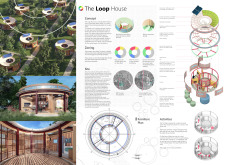5 key facts about this project
The design prioritizes spatial organization, featuring distinct zones for living, working, and leisure. Each unit is engineered to allow for dynamic adjustments, where rooms can be modified according to user preferences. This adaptive approach is central to the project, responding effectively to the challenges faced in densely populated urban areas.
Unique Design Approaches
One of the standout features of the Loop House is its adaptive wall system. Movable partitions enable residents to reconfigure their living space based on activities, thereby enhancing functionality. The circular layout encourages fluid movement within the space, contrasting with traditional linear housing patterns. This design promotes social interactions among residents while maintaining privacy when necessary.
Sustainability is also a pivotal aspect of the architecture. The incorporation of materials such as bamboo and solar panels reflects a commitment to environmental principles and local resources. The choice of wood for the primary frame lends an organic quality to the project, harmonizing with its natural surroundings. These materials not only ensure durability but also support local craftsmanship and production.
Architectural Plans and Sections
Reviewing the architectural plans and sections of the Loop House reveals a meticulous approach to spatial organization and environmental integration. The orientation of windows and operable panels captures natural light and facilitates cross-ventilation, reducing energy consumption for artificial lighting and cooling. This detail underscores the importance of climate-responsive design in contemporary architecture.
The Loop House represents an innovative response to urban living challenges through its adaptable, integrated, and sustainable design. To explore more about this project, including detailed architectural plans, sections, and design concepts, interested readers are encouraged to examine the project presentation for additional insights into its architectural ideas and solutions.























